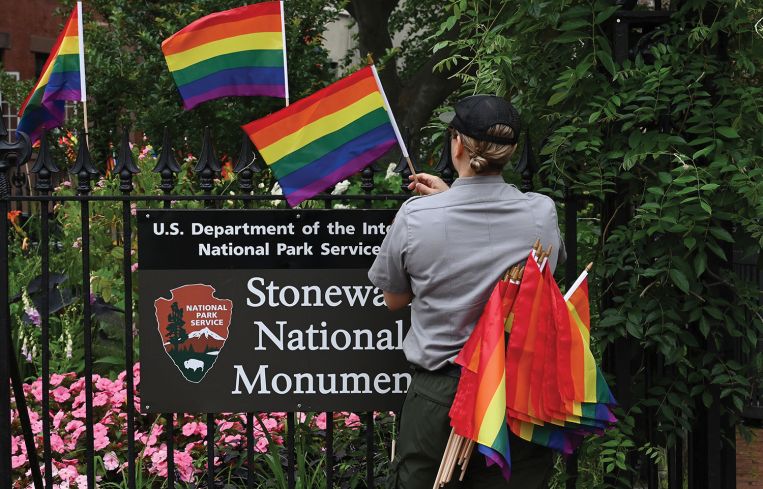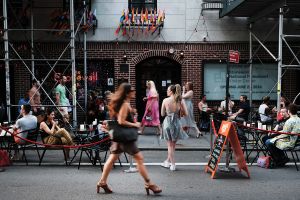The U.S. Has One LGBTQ National Monument, and It Took a Lot to Get There
What the Stonewall National Monument has meant for its Greenwich Village surroundings — and for the people tied to the property that started it all
By Abigail Nehring June 25, 2024 6:55 am
reprints
The struggle for gay liberation reached a new milestone May 31 when Pride Live’s Ann Marie Gothard rang the closing bell at the New York Stock Exchange, signaling a level of mainstream acceptance the 12-year-old nonprofit’s founders would have thought unfathomable just a decade ago.
It’s no coincidence that in the intervening years the National Park Service designated the nation’s first LGBTQ National Monument at the site of the 1969 Stonewall uprising, and a series of other properties across the five boroughs were placed on the National Register of Historic Places or designated local landmarks. The list includes the onetime homes of James Baldwin, Alice Austen and Lorraine Hansberry, plus the Greenwich Village bar Julius’ and Columbia University’s Earl Hall.
And a grassroots historic preservation effort is now taking off in places like California and Colorado.
“I think it’s important that kids know their history, to include LGBT people in history,” said Mardi Moore, executive director of Rocky Mountain Equality in Boulder County, Colo. “That’s why if you go inside our boardroom, you’ll see a reproduction of the first same-sex marriage license.”
Moore, whose life in activism spans both her native Boulder and New York City, is part of a recent effort to landmark the Boulder County Courthouse, where a clerk named Clela Rorex issued that marriage license to two men in 1975. The site is currently working its way through the nomination process.
On its home turf in New York, Pride Live is now the driving force behind the monthlong celebrations — an economic boost for the city — that culminate in Stonewall Day at Hudson Yards, a music festival hosted annually underneath Related Companies’ temporarily closed, döner kabob-esque Vessel on 11th Avenue. The headliner this year will be actress and singer Cynthia Erivo.
But 2024 will be a special year for Pride Live. In addition to kicking off the weekend’s events — which include the Pride Parade, “Pride at the Shops & Restaurants” and other goings-on in New York City — June 28 will be the day the Stonewall National Monument Visitor Center opens its doors at 51 Christopher Street — the place where it all began 55 years ago.
“When you talk about property in New York, to be able to bring 51 Christopher back into the hands of the community, I think that’s just really important,” said Diana Rodriguez, co-founder and CEO of Pride Live. “It is such a significant space in LGBTQ history.”
Pride Live raised $3.2 million to bring the Stonewall visitor center into being, and it will manage the center separately, but in collaboration with the National Park Service, whose rangers camp out across the street at the 5,171-square-foot Christopher Park, which comprises the National Monument.
The nonprofit organization seized their opportunity when the previous retail tenant, a nail salon, departed 51 Christopher Street in 2018, leaving the storefront vacant for several years. Pride Live signed a lease in 2022 for 2,100 square feet on the ground floor of the building that the city landmarked in 2015, and later brought on EDG Architecture to handle its design.
The architects uncovered some treasures in the process, including a passageway between 51 and 53 Christopher Street that had been sealed over with bricks. Now it will be visible behind a plexiglass window that allows visitors to gaze directly into the past.
The newfound national visibility of this pair of low-slung former stable buildings with a conjoined Arts and Crafts-inspired brick and stucco façade could prove a long-term boon for landlord Alan Wasserman, who did not respond to a request for comment by press time.
But, in fact, when it comes to historic preservation and real estate investment, the Stonewall National Monument — the first and thus far only LGBTQ site in the country to be turned into an official national monument — is the exception to the rule.
“If you think of the landmarked property as an amenity, it does have the impact of raising property values in the surrounding area,” said Sam Chandan, director of the Chao-Hon Chen Institute for Global Real Estate Finance at the New York University Stern School of Business. “But the landmarking itself significantly reduces how you might deploy or develop the space, so there can be a sort of dis-amenity feature.”
In the case of the Stonewall Inn — ground zero for the new national embrace of LGBTQ history — the concomitant surge in foot traffic on this julienned corner of the Greenwich Village Historic District is not necessarily a value-add proposition for owners in the area.
Chandan said the data is ambiguous on the impact of congestion since “it may or may not be the case that folks want to live in an area that has special appeal for tourism.”
Wasserman decided to roll the dice on the Stonewall property in 2015, when he paid $56.5 million to buy the corner lot between Seventh Avenue and Waverly Place from Benjamin Duell through a limited liability company. It was the first time the property had changed hands in 45 years.
Duell’s father, Manny Duell, previously acquired it in 1970 for an unknown amount from the late Burt Handelsman, who was once a partner in the firm that owned 51-53 Christopher Street. Handelsman rented it to a trio of investors — allegedly affiliated with the Genovese crime family — who cobbled together $3,500 to open a private club in 1967 catering to gay men. Rather than invent a new name for their establishment, they borrowed one that already existed, calling it the Stonewall Inn after Bonnie’s Stonewall Inn, a tearoom that set up shop on the premises circa 1930.
This level of detail is known to us today thanks to the fastidious work of historian David Carter, the author of Stonewall: The Riots that Sparked the Gay Revolution and also a key mover in the effort beginning in the 1990s to permanently preserve the site and raise awareness about the events that took place there over six days from June 28 to July 3, 1969.
“Literally nobody was addressing this history through landmark designations, or even just talking about how we were an important community that had its own history,” said Jay Shockley, a former senior historian for the New York City Landmarks Preservation Commission. He was another member of the small circle of historic preservationists who got the landmark conversation going, along with Gale Harris, Andrew Dolkart and Ken Lustbader.
It’s a little-known paradox in the recondite world of historic preservation that the National Register of Historic Places, which contains some 90,000 sites and is overseen by the National Park Service, plays almost no role in shaping the fate of these sites or protecting them from real estate interests (outside of a narrow set of rules that apply only to federally funded development projects like interstate highways).
“The National Register is important because it recognizes nationally important sites, but it doesn’t have any teeth at all,” Shockley said. “It’s an honorary listing. So properties on the National Register can be demolished.”
But for Shockley and his co-conspirators, the Stonewall Inn was a launching pad for the larger LGBTQ landmarking effort they went on to launch officially in 2015, calling it the NYC LGBT Historic Sites Project.
The group decided to take their moonshot in 1999 when there was momentum to nominate Stonewall to the National Register before the end of the Clinton administration, according to Shockley. There was just one problem: Private property owners wield veto power in the nomination process, and the Duell family was not on board.
The solution they came up with was rather creative, and explains much of how the Stonewall National Monument is set up today.
“The idea that you would include the streets — and David Carter had done all this research — and that you could incorporate the battle for the streets, made it a much richer story in a way,” Gale Harris explained in a 2019 oral history interview.
It was exactly the model previous generations of preservationists had used to nominate Civil War battlefields to the National Register. The small group in New York City took that argument and ran with it, nominating not just the Stonewall Inn itself but also the surrounding streets and the triangle-shaped Christopher Park, which all belonged to the city and therefore deprived the Duell family of its veto power.
The application quickly passed through the state-level historic designation process and was placed on the National Register in 1999. It was then fast-tracked to become a national landmark — a smaller group of about 2,500 sites with greater symbolic significance — by December of the same year.

It took until 2015 for the wheels of historic preservation to turn enough for New York City to designate 51 and 53 Christopher Street local landmarks. Ironically, it’s the local Landmarks Preservation Commission that carries actual power to restrict land use on landmarked sites, and which can step into the process to review building permits before any alterations are made.
That’s when Jonathan Miller, president and CEO of real estate appraisal and consulting firm Miller Samuel, got involved to appraise the pair of buildings, a job he was happy to do pro bono, he said.
But he never finished the job because “the landlord said no, at the time they weren’t open to selling,” Miller said. “Plus, that would involve big fundraising.”
It didn’t matter. The city landmark designation, which the New York City Council passed in 2015, provides a robust set of protections. And, the following year, then-President Barack Obama officially proclaimed the park across the street a national monument.
The monument and visitor center will work synergistically, if all goes according to Pride Live’s plan.
The ragtag team of historians behind the NYC LGBT Historic Sites Project, too, is pushing on to new shores. The list of local LGBTQ landmarks now includes a number of asset types across the five boroughs, and the group is also trying to boost similar efforts underway in San Francisco, Los Angeles, Chicago, Boston and elsewhere across the country.
Miller has a poignant memory of visiting Stonewall about 10 years ago.
“I’m sitting there on a sunny day outside of the Stonewall Inn next to a man who was probably 6-foot-6 in a purple chiffon dress, and we chatted,” Miller said. “It just reminded me how awesome New York City is. I was wearing a dark suit, and it was so emblematic of the village.
“These events in history matter.”
Abigail Nehring can be reached at anehring@commercialobserver.com.


